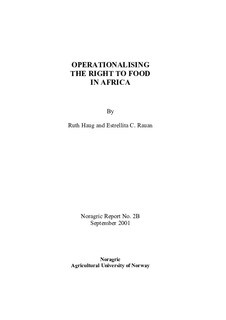| dc.description.abstract | This report focuses on how to implement the right to food in four countries in Africa (Ethiopia, Malawi, Tanzania and Zambia). The main purpose is to assess how rights-based development exemplified by the right to food can be better integrated in Norwegian development co-operation and how to better link international agreements and bilateral country support. The right to food is about how to foster conditions to enable people to care for themselves and their own food needs. The most appropriate way of fostering such conditions in Africa is by using the Poverty Reduction Strategy Plans (PRSP) as entry points and mechanism. Hunger and food insecurity is a poverty problem. Legislation alone annot solve the food insecurity problem although legislation might be one important tool in the struggle to eliminate poverty and food insecurity. Whether or not the countries have included food as a human right in national legislation does not appear to be of significant importance for the food security situation in the country. The critical issue regarding food as a human right is enforcement, not the legislation by itself.
Integrating the food as a human right approach in the ongoing poverty reduction processes is probably the most effective way of contributing towards a food secure Africa. In order for this integration to be successful, social mobilisation and empowerment is needed. Poor and hungry people need to have a voice in the policy formulation and implementation process and through this process claim their rights. What can be done by external actors such as Norway is, for example, support to public investment schemes. Food security responsibilities lie with national states. Resource availability at national level is an important, but not necessarily sufficient measure in implementing the right to food. The political will to end hunger and poverty is needed as well as resources and the ability to allocate resources in a wise way. In other words, the quality of public investments to facilitate pro-poor growth and social development is of crucial importance. The Sositmodel is applied for the agricultural sector to illustrate through a chain of events how allocated resources lead to services, achievements and impact; and what indicators which could be used to monitor the different steps in the process. However, achieving food security goes far beyond agriculture. A complex, multi-sector approach will be needed paying special attention towards human development, coping with conflicts and access to markets. The sustainable livelihoods framework will be an appropriate tool in this regard e.g., to include food security at household and individual levels. Each of the four countries is assessed and analysed for achievements in implementing the right to food including specific recommendations for possible public investment to achieve food security. | nb_NO |
